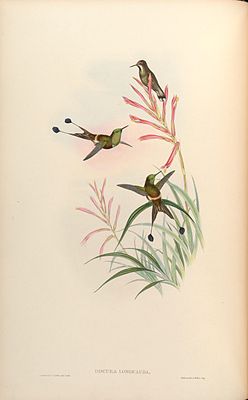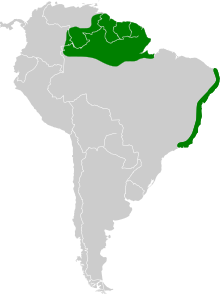Discus elf
| Discus elf | ||||||||||
|---|---|---|---|---|---|---|---|---|---|---|

Discus Elves at John Gould painted by Henry Constantine Richter |
||||||||||
| Systematics | ||||||||||
|
||||||||||
| Scientific name | ||||||||||
| Discosura longicaudus | ||||||||||
| ( Gmelin, JF , 1788) |
The discus elf ( Discosura longicaudus ) is a species of bird in the hummingbird family (Trochilidae). The species has a large range that covers about 1,900,000 square kilometers in the South American countries of Venezuela , Guyana , Suriname , French Guiana, and Brazil . The IUCN assesses the population as not at risk ( least concern ). So far, no subspecies of the discus elf is known. The species is therefore considered to be monotypical .
features
The male discus elf has a body length of about 10.2 cm, while the female is only 6.9 cm tall. They have a weight of approx. 3.4 g. In the male's forked violet tail, the outer control feathers are about 5 cm longer than the rest. At the ends there are two black-violet flags. The crown, neck and upper chest are shiny emerald green. The lower part of the chest is copper gold and turns white on the belly. The back sparkles green and has a yellow-brown whitish band on the rump . The female does not have such glittering green feathers. The upper side is similar to that of the male, also has a yellow-brown whitish band on the rump. The black throat is lined with white on the sides. The breast shines green and turns yellowish brown white on the belly. The tail, which is also forked, reaches a length of approx. 2.5 centimeters, but has no flags at the end. It is gray with a distinct purple subterminal area. The outer feathers have white speckles.
behavior
You can usually see them in the treetops of hapaxanthine plants , where they collect nectar together with other hummingbird species. They mostly steal the nectar from larger territorial hummingbirds and it is not uncommon for them to be chased away by them. Their flight is relatively slow and resembles that of bees. Very often they sit on the branches in the outer area of tree tops. Among other things, they fly to the flowers of Inga arten and Kaschu .
distribution and habitat
The bird moves in the tropical zone. It can be seen preferably on rivers in the rainforest. Mostly it can be observed at forest edges and secondary forest. They move at heights of up to 400 meters, but mostly only up to 200 meters in the central and western part of the Venezuelan state of Amazonas . In Brazil they can be found in the north and east of the country.
Etymology and history of research
Johann Friedrich Gmelin used the protonym Trochilus longicaudus . Only later was the discus elf of the new genus Discosura slammed by Charles Lucien Jules Laurent Bonaparte .
The name “Discosura” is derived from the Greek words “diskos” δίσκος for “plate, disk” and “oura” οὐρά for “tail”. The specific epithet "longicaudus" is of Latin origin and comes from the words "longus" for "long" and "cauda" for "tail".
literature
- Steven Leon Hilty, John A. Gwynne, Guy Tudor : Birds of Venezuela . Princeton University Press, Princeton 2002, ISBN 978-0-691-09250-8 .
- Rodolphe Meyer de Schauensee , William Henry Phelps, Jr. , Guy Tudor: A Guide to the Birds of Venezuela . Princeton University Press, Princeton 1992, ISBN 978-0-691-08205-9 .
- Rolf Grantsau : The hummingbirds of Brazil . Expressão e Cultura, Rio de Janeiro 1988, ISBN 978-85-208-0101-7 .
- James A. Jobling: Helm Dictionary of Scientific Bird Names . Christopher Helm, London 2010, ISBN 978-1-4081-2501-4 .
- Johann Friedrich Gmelin: Systema Naturae per Regna Tria Naturae, Secundum Classes, Ordines, Genera, Species, Cum Characteribus, Differentiis, Synonymis, Locis . tape 1 . Georg Emanuel Beer, Leipzig 1788 ( online [accessed May 19, 2012]).
Web links
- Discosura longicaudus inthe IUCN Red List of Threatened Species 2011.2. Listed by: BirdLife International, 2009. Retrieved March 19, 2012.
- BirdLife International: Species Factsheet - Racket-tailed Coquette ( Discosura longicaudus ) . Retrieved March 19, 2012.
- Videos, photos and sound recordings of Racket-tailed Coquette (Discosura longicauda) in the Internet Bird Collection
- Discus Elves ( Discosura longicaudus ) at Avibase; Retrieved March 19, 2012.
- Discosura longicaudus in the Integrated Taxonomic Information System (ITIS). Retrieved March 19, 2012.
- xeno-canto: Sound recordings - Racket-tailed Coquette ( Discosura longicaudus )

